 THIS young woman glides effortlessly up the rocky path beneath the forest. In her hand is a furled umbrella, on her back a small sack. As she passes she whispers a polite “hola” then disappears around one of the many zigzag bends that climb steeply from Val de Valarties.
THIS young woman glides effortlessly up the rocky path beneath the forest. In her hand is a furled umbrella, on her back a small sack. As she passes she whispers a polite “hola” then disappears around one of the many zigzag bends that climb steeply from Val de Valarties.
Above the forest, unseen but not unfelt, is the mighty mass of Montardo – one of the classic peaks of the Spanish Pyrenees. At 2,833 metres (that’s 9,294ft), it dominates the view along the winding valley road from the campsite at Arties in Val d’Aran – huge buttresses of rock painted pin k in the dawn; a great castle of a mountain. But from the claustrophobic forests of its lower slopes, where I sit panting on a rock, it is unseen. Just felt.
k in the dawn; a great castle of a mountain. But from the claustrophobic forests of its lower slopes, where I sit panting on a rock, it is unseen. Just felt.
After a very sweaty and quite unpleasant slog up through the forests, I emerge on the edge of a beautiful mountain lake – Era Restanca – where is situated the large and imposing Refugi dera Restanca (right). The Pyrenean refuges have no equivalent in Britain. To call them youth hostels would be an understatement. Although they perform similar functions to hostels, they are, almost without exception, situated in high and remote areas, many miles from nearest roads.
My route to the summit of Montardo follows one of the marvellous Grande Randonnées – or Gran Recorruts, as the Spanish call them – the waymarked long-distance paths of France and Spain. They are invariably marked with  stripes of white and red paint, like little Polish flags, daubed on rocks every few hundred metres or at bends and junctions.
stripes of white and red paint, like little Polish flags, daubed on rocks every few hundred metres or at bends and junctions.
I am on the GR 11.18 at this point, and it lifts me through some breathtaking mountain scenery, past a second spectacular mountain lake – Estrath deth Cap deth Port (right) – to the rocky pass of Coll de Crestada. At a wild guess, I’d say this translates as the col on the crest – a fair and descriptive enough name in anybody’s book.
I climb through the col, which is a defile between rocky outcrops, and am confronted by the most magical of views: snow-capped mountains as far as the eye can see, suspended beneath a clear blue sky. And in the middle distance, a mile or so away and a little beneath me, is a jewel of a lake – Estany de Monges – almost a third of its surface white with ice. What an incredible and unexpected scene.
On the col, the GR 11 and GR 18 fork and go their separate ways. I follow the former about a hundred metres until I chance upon a metal signpost and a man leaning against it. As I squint into the sunlight to read the words, the man says simply: “Montardo.” If ever a sign was less needed then this is it.
The western satellite summit of Montardo looms above me like the Tower of Babel, incredibly steep and girdled with broken crags. Snowfields fill a great bowl between two  rocky ridges leading to the true summit, and up the centre of the bowl I climb, tramping up this wide ramp of snow and hopping from boulder field to boulder field.
rocky ridges leading to the true summit, and up the centre of the bowl I climb, tramping up this wide ramp of snow and hopping from boulder field to boulder field.
There is a Spanish couple a few hundred metres ahead of me. On the climb up to the Coll de Crestada, the hombre and his señora were a similar distance behind me, and I can only assume they crept in front while I was scampering about in the snowfields trying to find the safest way through. I overtake the couple on the steep ascent from the snowfields to the rocky south-east ridge. The hombre mutters something as I pass. It might be hola.
On the path to the final summit, while I am taking pictures, the hombre and his señora overtake me a second time. Again he grunts something barely audible. But before we reach the summit, he takes a wrong turn up a blind path, so I arrive at the top a minute or two before them.
I am at an altitude of 2,833 metres on the highest mountain I have ever climbed and in a deliciously cold wind. The views from the summit of Montardo stretch to every horizon, mountain after mountain, ridge after ridge, rolling north into France and south into Spain to merge many dozens of miles away into the blue of the sky.
 The hombre arri
The hombre arri ves on the summit and immediately bursts into an extremely vocal appreciation of his mountain environment. He is so enchanted that he offers to take a picture of me – with my own camera – at the summit cairn. Which he does. And a fine picture it is too.
ves on the summit and immediately bursts into an extremely vocal appreciation of his mountain environment. He is so enchanted that he offers to take a picture of me – with my own camera – at the summit cairn. Which he does. And a fine picture it is too.
We stand there like old friends, him with his three words of English, me with my two words of Spanish. But you don’t need words to share an achievement. The sense of euphoria transcends the language barrier. We’re on top of the world – me, the hobre, his señora – surrounded by the most wonderful panorama of rocky mountains, snowfields and deep shady valleys.
 A couple of hours later I’m standing outside the front door of the Refugi dera Restanca, all hot and dusty though absolutely brimming with contentment. I am gagging for a drink, so decide to sample the refreshments the guidebook says I will find within.
A couple of hours later I’m standing outside the front door of the Refugi dera Restanca, all hot and dusty though absolutely brimming with contentment. I am gagging for a drink, so decide to sample the refreshments the guidebook says I will find within.
After stumbling in the wrong direction along a maze of echoing passages, I chance upon an austere though clean dining area with a serving hatch to a kitchen. I stick my head through the hatch to order a can of lemonade. Three women are cooking stew. The young woman who passed me this morning on the steep forest trail serves me.
In the silence of the dining room, I sit with my thoughts, my sore feet and my lemonade.
Christ, I say to myself. The young woman with the umbrella. This must be her day job. Does she slog up that 1,200ft nightmare of a zigzagging forest path every morning? What a way to earn a living.
Then I consider the wider picture. If I was given the choice between climbing halfway up a Spanish mountain every morning with the sun on my back, or scuttling through cold wet streets to a dilapidated office in a grey North-East town, which would I choose?
Hmmm . . . Have to think about that one.
Montardo. Put it on your list. Climb it. A beast of a mountain in a breathtakingly beautiful wilderness. And great lemonade.
















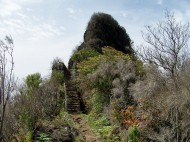
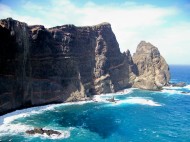


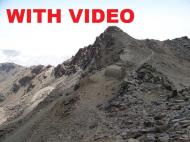




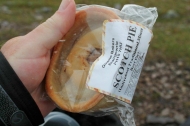



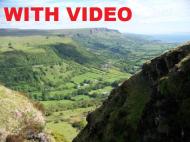

Fantastic.
I can see another trip I can’t afford coming up. Can I afford not to go though, eh?
Great Pictures too.
If you’re ever in the area, Alan, the tobacco stores in Vielha sell a map and guidebook package that has an English section. They’re as cheap as chips, so that cuts the costs down. I don’t think I mention this in the article, but the Montardo walk is in it, and a few more that I never got round to doing. But as well as the costs, I have a wife who has started insisting on guarenteed sunshine on holidays – so I’ve two obstacles to overcome before I go back.
Hi! Wow, I got really curious about this mountain, mainly because Montardo is my last name! I’ve always heard that it was an Italian surname, but now I think there must be a relation to this mountain. Where exactly is it in Spain? Which famous Spanish city is it nearby? I must go there! Hugs from Brazil!
Hi Ana. The nearest town to Montardo is Vielha, which is only a few kilometres from the French border right in the middle of the Pyrenees. A few kilometres east of Vielha along the C-28 road is a village called Arties, and Montardo lies directly south of the village. This map might work.
Hope this is of some assistance. Regards, Alen McF
Reblogged this on hannaswalk – ok mostly others at the moment and commented:
Great story and stunning pictures!
Yup. Came by the Montardo on my way from the Mediterranean to the Atlantic. Was too lazy to go up the little that remains from Col de la Crestada and too eager to get to Restança – am major mistake as I see now!
I think, Bern, that walking from the Med to the Atlantic is in a totally different league. I’m sure I would have given it a miss as well. In fact, I don’t think I’d have got that far!
Cheers, Alen